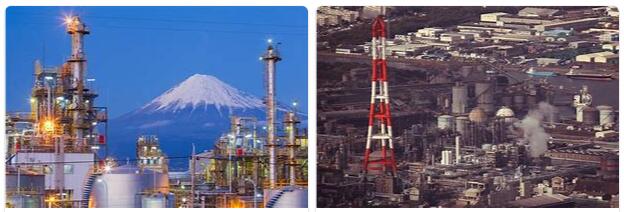The textile sector still has a prominent place in the Japanese economy. Although the traditional silk mill has decayed, other textile industries are thriving. The decline of the silk factory can be seen from the reduced production of cocoons (see above) and the decrease in the number of basins (46,756 in 1956 against 535,000 in 1936). In 1956, some 175 million m 2 of silk fabrics were manufactured. The main export market is the United States, which also buys raw silk.
The artificial fiber industries had a great recovery after the war. In 1958 84,840 t of long fiber rayon and 241,680 t of staple were produced (Hiroshima, Yamaguchi, Shiga, Ehime, Miyazaki, Tokushima, Kumamoto, etc.; total production in 1933: 44,420 t).
New nylon and other synthetic fiber industries have also developed (in Nagoya, Kurashiki, Okayama, Amagasaki, Sakoshi, Yodogawa, Ogaki, Iwakuni, Nobeoka and Inagawa).
The Japanese cotton mill, severely hit by the territorial losses of the country, which deprived it of the availability of a part of the raw material and of important outlet markets, has slowly recovered by finding other ways for its trade (production of fabrics in 1956: 2,900 million m 2). Almost all of the raw material is imported from the USA (which, moreover, were among the main suppliers even before the war). Exports are turning instead to new markets in South and Southeast Asia and Africa. Imports of raw cotton and exports of cotton mill products are among the most important items of Japanese international trade (raw cotton accounted for 23.7% of imports in 1951, while cotton fabrics and yarns accounted for 23, respectively, 3 and 2.5% of exports in value).
The wool mill now has 2,152,000 spindles and 26,923 looms against 300,000 spindles and 2,000 looms in 1936. The production in 1956 was approximately 105,000 t of products. The raw material is mostly imported.
Among the chemical industries, those that produce fertilizers, essential to ensure the excellent yields of food crops, have regained their pre-eminent position. Mainly nitrogen and phosphate fertilizers are produced. The mineral phosphates required are mostly imported from the USA, Oceania, Egypt and Morocco (1,507,396 t in 1958).
Main centers of these industries are: Shimonoseki, Hakodate, Omuta, Nagoya, Sunakawa, Yokohama, Kawasaki, Niihama, Beppu, Hachinohe, Osaka, Toyama, Yokkaichi, Minamata. Here are the 1958 productions: ammonium sulphate 2,610,000 t, urea 480,000 t (half of world production), ammonium nitrate 23,000 t, ammonium chloride 134,000 t, calcium cyanamide 440,000 t (one third of world production), superphosphates 1,300. 000 t, liquid magnesium phosphate 400,000 t, ammonium phosphate 238,000 t, other compound fertilizers approximately 1,750,000 t. A part of the chemical fertilizers produced is exported to South Korea and other countries in Southeast Asia, Latin America and Africa (for a total value in 1958 of about 20 billion yen).
According to ASK4BEAUTY.COM, the production of sulfuric acid is among the largest in the world, thanks to the abundance of pyrites existing in the subsoil (3,378,000 tons extracted in 1957). The major factories for the production of sulfuric acid are located in Hitachi, Saganoseki, Osaka, Besshi, Shimonoseki, Omuta, Wakayama. Production in 1958 was 3,904,000 t.
Even the production of caustic soda has now become among the largest in the world, despite the lack of sodium chloride, which is remedied with heavy imports of raw salt from China, Indonesia, Egypt, the USA, Aden (a total of 1,699,346 t in the 1958). The main factories are in Makiyama, Tokuyama, Yokkaichi, Ube, Oji, Toyama, Nagaoka, Amagasaki, Yokohama, Nobeoka, Okayama, Kokura. This industry after the war crisis had a slow recovery which brought it back to pre-war level in 1954. Subsequently, production has further and significantly increased to reach 677,000 t in 1958. In that year around 23,000 t were exported (especially to Brazil, Korea, Pakistan, Indonesia, the Philippines and Thailand).
The new polyvinyl chloride industry is also rapidly developing (electrical insulation, pipes – including aqueducts -, semi-finished products, for a total of 107,000 t in 1958, of which about 17,000 were exported) and that of photosensitive materials (in 1958: 10 million m 2 of film and 16 million m 2 of sensitive paper, with exports to almost all of Asia and Latin America). The pharmaceutical industry has made great progress in recent years, exporting 60% of its production to Asian markets. Some exports of pharmaceutical products are also directed to the USA and Brazil.
Size of large industry has rubber processing (tire and shoe production) with 67,000 employees. Natural rubber is imported from Malaysia, Ceylon, Indonesia, British Borneo, Singapore (138,537 t imported in 1958). The synthetic rubber comes from the USA, Canada, West Germany (a total of 17,280 t in 1958). The main factories are located in Tokyo, Kobe, Osaka, Kurume, Sendai and Otaru. Annual production is around 100,000 tons of manufactured goods.
The paper industry, damaged by the loss of availability of Sakhalin timber, imports part of the raw material from Korea, Canada and the USSR. The main paper mills are located in Tomakomai (in Hokkaido), Tokyo and Osaka (in 1958, among other things, 571,000 tons of newsprint were produced).
The cement industry, which in 1939 had reached a production of 6,199,724 t, in the first postwar year (1946) produced just 900,000 t. The following year the recovery began, so much so that in 1951 the pre-war level of production was reached. In 1956, 13 million tonnes of cement were manufactured; in 1957 and 1958 the production was maintained at around 15 million tons per year. Cement factories are very popular because (as usually happens) they are located near the quarries of the raw material, quite common in the country. Exports are considerable but are very sensitive to international economic conditions (1954: 900,000 t; 1955: 1,450,000 t; 1956: 2,350,000 t; 1957: about 2,000,000 t; 1958: only 1,480,000 t, due to the of the economic recession of that year). The usual importers are: Southern Vietnam, Cambodia, Laos, Philippines, Indonesia, Hong Kong, Singapore, Malaysia, Thailand and Burma. In 1956 there were also strong purchases by Communist China and the Persian Gulf countries.
